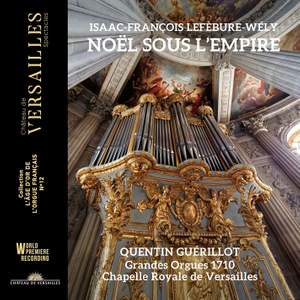Noël sous l'Empire: organ music from Versailles
This is clearly a labour of love from Guerillot; and what a Christmas discovery this is!

This is a rather nice Christmas idea: extracts from Recueil de tous les airs consacrés pour le temps de Noël et arrangées pour l'orgie par Isaac François Lefébure-Wely, organiste de l'Église Saint-Roch, Paris, 1823 (“Collection of all the airs devoted to the season of Christmas and arranged for organ”). Quite the mouthful, but this is a phenomenally interesting collection.
This collection is directly in the lineage of the Noëls by Daquin (1694-1772); there are 34 in toto by Lefébure-Wely), and these pieces are some of the last examples of that line. The organist here, Quentin Guérillot, suggests that these pieces are “undoubtedly a fairly realistic reflection of the improvisations of the great organists of the time.” Of the Noëls, there are three types: those indebted to Daquin and of classical construction, more pianistic (remember one of Daquin's pieces, Le coucou, was once a popular encore for pianists); Noëls using characteristic and new sonorities such as the oboe, the human voice and the tremolo, inspired by the early opéra-comique and influenced by orchestral writing,;and those inspired by romances for voice and fortepiano (most often performed on.organ flutes). One can hear the use of the oboe and the trumpet stops, for example, in Ô ma tendre Musette (track 14), which uses “Trompette de Bombarde” and “Le hautbois” (oboe) at 4"01: this is the second longest track on the disc.
We don't know too much about Isaac-François Lefébure-Wely. He was born in Rouen 1754 or 1756. It's probably a bit niche to say he's not the Lefébure-Wely, but if you've heard of the surname it is more likely his son, Louis James Alfred Lefébure-Wely; this is apparently the first of the father's works to be recorded, and yet he was prolific, and not only in composition, but also as a music theorist. He wrote - wait for it - SIX treatises on the fugue (!) along with 14 Suites, at least a dozen masses and an opéra comique in two acts.
Much research by Guirillot has gone into the performance style used, specifically comparative study of Guillaume Lasceux's Essai théoretique et pratique with published contemporary organ works. In so doing one can see how the written scores were embellished (also, the addition of a pedal part was expected).
Here's the promotional video from Château de Versailles Spéctacles:
There are some pieces not by Lefébure-Wely. Guerillot is joined by the phenomenal Maud Bessard-Morandras for two stunning settings of O Salutaris by Jacques-Marie Beauvartet-Charpentier (1766-1834), each as sublime as the other. Bessard-Morandras ha a voice of the utmost purity and beauty. As to the composer, this particular “Charpentier” was organist at Saint-German-des-Près and then Saint-Eustache. There is also a Pater Noster by Cherubini for voice and organ, beautifully sung by Bassard-Morandras.
As there are so few YouTube video inputs for this disc, here's Bessard-Morandras singing some very colourful Alessandro Scarlatti: “Se il cor mio dolor t'offende” from the opera Griselda at the 2022 Cesti Competition:
Following the first O Salutaris, back to Lefébure-Wely for a joyful, skipping Tambourin. There's a rather nice touch at one point when Lefébure-Wely presents a short, charming Noël (Suisse) and then immediately after there is a fugue and a single variation on the melody of that Noël (Même Noël Queen le précédent dont le Thème est fugué et suave dune variation). It is fascinating, not least because of Guerillot's performance. He refers in his notes to the pieces a “virtuosic” and this one certainly is, but Guerillot does not slow down even the slightest amount - the result is a glorious flight of the imagination.
There is so much to discover here. A personal favourite of mine is the Cantique de St. Nicolas (Noël bourguignon - “Grand Dei, ribon ribaine”), incredibly appealing and yet fully virtuoso. It is followed by a more straight-laced set of variations, a “Noël varié,” on the offertory, “À la venue de Noël” before the collection closes with its longest piece, Salut du Jour de Noël, et du Jour des Saints innocents: le Motet verbum caro, a piece for soprano and organ. There are some lovely chromaticism to both melodic line and harmony. The text, “Verbum caro factus est,” means “And the Word was made flesh,” referring to the human incarnation of the Christ energy (there is sadly an error in the booklet in which the translations get mixed up, so the English translation has first and third verses in English but first line of the middle one in German; the German one is fine throughout, but the French translation has verses 1 and 3 in French and the first line of the second verse in English ...).
That small error aside, this is a characteristically detailed booklet that tells us much about a composer and theorist whose works are little known. This is clearly a labour of love from Guerillot; and what a Christmas discovery this is!
This excellent disc is available from Amazon via this link.
